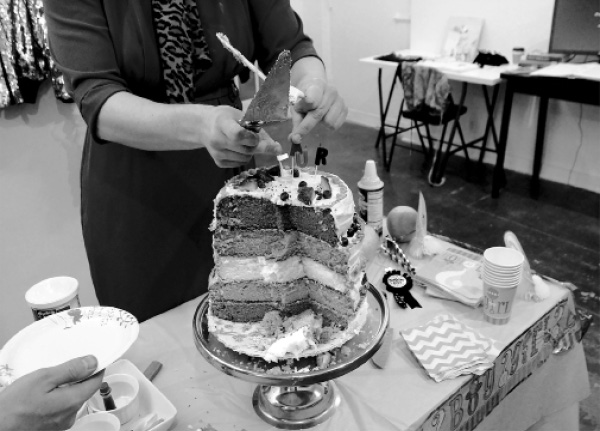
LIFE'S A DRAG
first performed on September 23, 2017
Front/Space, Kansas City, MO
performed once in 2017
LAURENCE MYERS REESE
Keeva Danielle Lough
Norman, OK
757747904l757747904.757747904m757747904y757747904e757747904r757747904s757747904.757747904r757747904e757747904e757747904s757747904e757747904@757747904g757747904m757747904a757747904i757747904l757747904.757747904c757747904o757747904m
LIFE'S A DRAG
LAURENCE MYERS REESE
“Life’s a Drag” explores trans identity, gender performance, drag culture, and my experience as a transmasculine drag queen.
Performing as my drag persona Marlene Schiedich, I invited the audience to attend a non-traditional transgender reveal party. Patterned off a cis-heteronormative celebration to reveal the sex of an unborn child, this event asks “Is it a Boy or a Girl?” A five-layer cake was cut and served to the audience, revealing my “true gender.” The cut cake revealed the pattern of a transgender flag, eschewing both gender essentialism and the binary expectations even trans people face as they come out.
I then proceeded to regurgitate icing, “sugar coating” the language around the trans experience, repeating phrases and questions trans people often hear, specifically those I have personally heard, no matter how benign or insulting. This is an inversion of the witty banter drag queens are often expected to improvise for entertainment.
The standard “gender reveal party” divulges the sex of the child (in utero) to its (most likely) heterosexual parent(s). This celebration, precipitating the arrival of the child, narrowly categorizes a child into “boy” and “girl” based on developing sex characteristics. This application of “gender” and public acknowledgement of the child’s sex prepares the parents, family, and social group for an expectation of what a child’s personality, interest, and identity might be, leading to a lifelong struggle confined in binary gender roles, for both trans children and cisgender children.
Drag queens are traditionally thought of as gay men “impersonating” women, reducing them to a male/female binary. This ignores the history of drag which includes transwomen and transmen as leaders in the movement. Drag has recently found a mainstream foothold again, but this resurgence has primarily left out transgender people. Meanwhile, television programs like “I Am Jazz” and “I Am Cait” profit off the narratives of transgender individuals, often packaging transition stories as neat and binary.
The rituals and culture we participate in are made binary, despite attempts to change them. “Life’s A Drag” continues a storied conversation around gendered performance, participation in trans narratives, and our complicit participation in the profit from gendered structures.